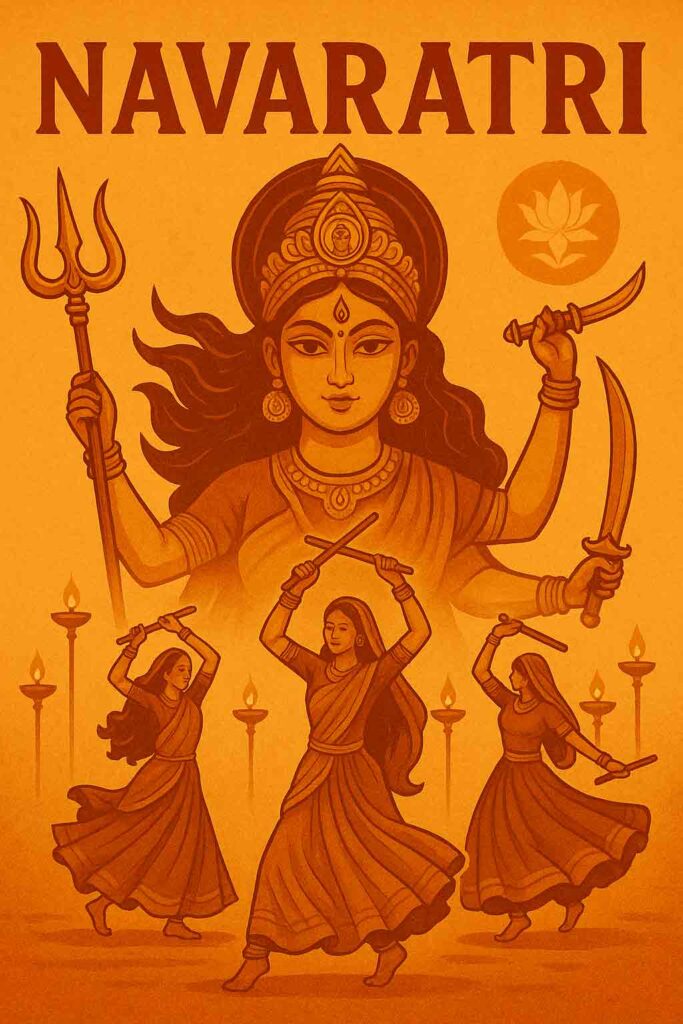Navaratri (Twice a year-Chaitra & Sharad Navratri)
Nine nights dedicated to the worship of Goddess Durga in her nine forms.

Navaratri, meaning “nine nights” in Sanskrit, is one of the most celebrated and spiritually significant Hindu festivals in India. It is dedicated to the worship of Goddess Durga and her nine divine forms, each symbolizing different aspects of power, purity, and feminine energy. Observed for nine nights and ten days, Navaratri signifies the victory of good over evil, light over darkness, and knowledge over ignorance. The festival usually falls in the Hindu month of Ashwin (September–October) and culminates in Dussehra or Vijayadashami, marking Lord Rama’s triumph over Ravana and Goddess Durga’s victory over the demon Mahishasura. Though celebrated across India, each region observes it with its own traditions, rituals, and cultural expressions, reflecting the rich diversity of the country.
The essence of Navaratri lies in the worship of the Divine Feminine, known as Shakti. According to Hindu mythology, when the demon Mahishasura became invincible after being granted a boon that no man could kill him, the gods combined their energies to create a powerful goddess—Durga. Mounted on a lion and armed with divine weapons, she fought a fierce battle against Mahishasura for nine days and nights. On the tenth day, she defeated him, symbolizing the triumph of righteousness over evil. Hence, Navaratri celebrates not just the power of the goddess but also the inner strength within every human being to overcome negativity, ego, and ignorance.
Each of the nine days of Navaratri is dedicated to one of the nine forms of Goddess Durga—Shailaputri, Brahmacharini, Chandraghanta, Kushmanda, Skandamata, Katyayani, Kalaratri, Mahagauri, and Siddhidatri. Devotees observe fasting, prayers, and meditation, seeking blessings for health, prosperity, and spiritual growth. The festival also encourages self-discipline, purification, and reflection, as devotees abstain from certain foods and focus on spiritual upliftment. Homes and temples are beautifully decorated, and the air is filled with devotional songs, the sound of bells, and the fragrance of incense.
Navaratri’s cultural expressions vary widely across India. In North India, especially in states like Uttar Pradesh, Delhi, and Punjab, Ramlila performances depict episodes from the Ramayana, culminating in the burning of Ravana’s effigy on Dussehra, signifying the destruction of evil. In West Bengal, Durga Puja is the highlight, where beautifully crafted idols of Goddess Durga are installed in elaborately decorated pandals. The final day, known as Vijaya Dashami, sees the immersion of the idols in water bodies amidst music, dancing, and chanting. In Gujarat and Maharashtra, the festival is synonymous with vibrant Garba and Dandiya Raas dances, where men and women dressed in colorful traditional attire gather every night to dance in circles around the symbolic representation of the goddess. In South India, Navaratri is marked by the display of Bommai Kolu or Golu, an artistic arrangement of dolls representing gods, goddesses, and mythological scenes. Families visit each other’s homes, exchange gifts, and sing devotional songs. In Tamil Nadu, Andhra Pradesh, and Karnataka, the festival also honors Saraswati, the goddess of learning, and young girls are worshipped as embodiments of divine energy.
Beyond its religious significance, Navaratri embodies the spirit of unity, joy, and renewal. It serves as a reminder of the cyclical nature of life—where struggle, perseverance, and eventual victory are constant themes. The festival unites people from all backgrounds in celebration, reflecting India’s deep cultural and spiritual diversity. Economically, Navaratri also stimulates local economies, with artisans, craftsmen, and performers contributing to the festive atmosphere through art, dance, music, and food.
At its core, Navaratri is a celebration of Shakti, the universal energy that sustains creation and transforms destruction into rebirth. It teaches that true victory is achieved through inner strength, devotion, and righteousness. Whether through fasting, prayer, dance, or community gatherings, the festival inspires self-purification and the pursuit of truth. As the nine nights unfold, they symbolize a spiritual journey—from darkness to light, from ignorance to wisdom, and from human limitation to divine realization. In this way, Navaratri transcends time and geography, continuing to illuminate hearts and homes with faith, color, and divine grace.
